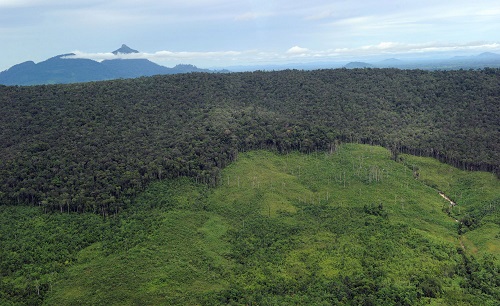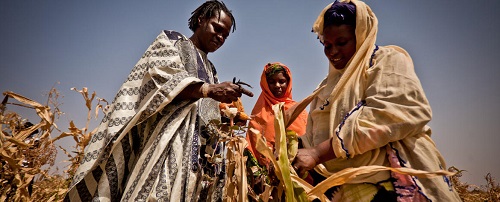2017 SkS Weekly Climate Change & Global Warming News Roundup #20
A chronological listing of news articles posted on the
Skeptical Science Facebook page during the past week. Articles of high signifigance are highlighted in the
Editor's Picks' section.
Editor's Picks
Receding forest on a mountainside in West Kalimantan province in Borneo

Receding forest on a mountainside in West Kalimantan province in Borneo. ROMEO GACAD/AFP/GETTY IMAGES
Palm oil is the second-most important oil in the modern consumer society, after petroleum. Producing it is a $50-billion-a-year business. It’s in a multitude of the household products in North America, Europe, and Australia: margarine, toothpaste, shampoo, lipstick, cookies, Nutella, you name it. Doritos are saturated with palm oil. It’s what gives chocolate bars their appetizing sheen – otherwise, they would look like mud. Palm oil has replaced artery-clogging ghee as India’s main cooking oil. India is now the major consumer of this clear, tasteless oil squeezed from the nuts of the oil-palm tree, Elais guyanensis,originally from West Africa, but now grown pantropically, mainly within ten degrees north and south of the Equator.
Indonesia and Malaysia chose palm oil as their main economic engine after independence in the 1960s, and they together account for 85 percent of world production, which is expected to double by 2050. As oils go, palm oil gives you the best bang for your buck. Soy fields yield far less than rows of oil-palm trees and have to be replanted annually, while the palms keep bearing huge clusters of oil-rich nuts for 20 years, and can then be replaced. In 2015 17 million hectares of oil palm yielded a total of 62 million tons of oil, while the 120 million hectares planted in soy yielded 48 million tons. Palm oil doesn’t lose its properties when it’s heated, or become rancid at room temperature, and it has multiple industrial uses. It is the edible vegetable oil of choice and is not going away.
Borneo is ground zero for oil-palm devastation. Nowhere has more native rain forest been wiped out. The world’s third-largest island, Borneo’s lower 73 percent is in Indonesia— the territory of Kalimantan— and its upper portion consists of two states in Malaysia, Sarawak and Sabah, separated by the small, oil-rich sultanate of Brunei. Fifty percent of the lowland Borneo rain forest, which once covered all of the island up to 10,000 feet, is gone, but it’s still the third-largest in the world, after the Amazon and Equatorial Africa’s. It is part of the most ancient rain forest— forest, period— on earth: 130 million years old, more than twice as old as the Amazon’s, and has the greatest density of higher plant species, an estimated 15,000 flowering species. Each new botanical or entomological expedition comes back with new species. Some 20,000 insect species have been found in Sarawak’s Gunung Mulu National Park alone.
Vanishing Borneo: Saving One of the World’s Last Great Places by Alex Shoumatoff, Yale Environmnet 360, May 18, 2017
Climate change could slash staple crops: Study

Photo - Oxfam International/flickr
Climate change, and its impacts on extreme weather and temperature swings, is projected to reduce global production of corn, wheat, rice and soybeans by 23 percent in the 2050s, according to a new analysis.
The study, which examined price and production of those four major crops from 1961 to 2013, also warns that by the 2030s output could be cut by 9 percent.
The findings come as researchers and world leaders continue to warn that food security will become an increasingly difficult problem to tackle in the face of rising temperatures and weather extremes, combining with increasing populations, and volatile food prices.
The negative impacts of climate change to farming were pretty much across the board in the new analysis. There were small production gains projected for Russia, Turkey and Ukraine in the 2030s, but by the 2050s, the models “are negative and more pronounced for all countries,” the researchers wrote in the study published this month in the journal Economics of Disasters and Climate Change.
Climate change could slash staple crops: Study by Brian Bienkowski, The Daily Climate, May 19, 2017
Trump Budget Would Wallop EPA's Climate and Environment Programs

The White House budget is only the first step in a long process. Congress members are already raising concerns. Credit: Jim Watson/AFP/Getty Images
Details of President Donald Trump's 2018 budget proposal, leaked this week, reveal that the administration appears determined to wallop environmental programs, including many that tackle climate change. It would cut Environmental Protection Agency funding by nearly one-third, slash spending on renewable energy innovation, and eliminate the Greenhouse Gas Reporting program, among other programs.
The White House only has the first move in the long budget process; once the proposal is unveiled officially next week, it will be Congress' turn to weigh in on spending priorities. With Trump embroiled in scandal, and many popular programs targeted for elimination, it's not at all clear that lawmakers will follow the president's lead.
The president's so-called "skinny" budget, released in March, also called for slashing EPA funding by 31 percent but was light on detail.
This second version of the budget proposal, leaked late this week, reveals that the administration intends to follow through on its commitment to reduce EPA to the size it was in the 1970s, when climate change wasn't on its radar screen.
Research on air and energy would be slashed by 67 percent, and clean air regulatory programs—which include climate change—would be cut 47 percent.
Trump Budget Would Wallop EPA's Climate and Environment Programs by Georgina Gustin & Marianne Lavelle, Inside Climate News, May 20, 2017
Links posted on Facebook
Sun May 14, 2017
- Happy(?) Birthday Temperature Spiral by Andrea Thompson, Climate Cnetral, May 11, 2017
- Advisory Committee Shakeup Targets Independent Science and Scientists by Geena Reed, Union of Concerned Scientists, May 12, 2017
- Support: Monumental Hands Rise from the Water in Venice to Highlight Climate Change by Christopher Jobson, Colossal, May 12, 2017
- Trump is deleting climate change, one site at a time by Oliver Milman & Sam Morris, Guardian, May 14, 2017
- Farewell, giant pine: Climate change kills a champion at Washington Park Arboretum by Lynda V Mapes, Seattle Times, May 13, 2017
- No Third Way for the Planet by Kate Aronoff, Jacobin, May 10, 2017
- Temperature Increase To Exceed 1.5° Celsius “Barrier” By 2026–2031, Research Finds by James Arye, CleanTechnica, May 14, 2017
Mon May 15, 2017
- Africa feeling the heat of climate change, Africa Renewal, The New Times (Rwanda), May 14, 2017
- Germany Just Smashed an Energy Record, Generating 85% Electricity From Renewables by Kristin Houser, Futurism, May 10, 2017
- A new book ranks the top 100 solutions to climate change. The results are surprising. by David Roberts, Energy & Environment, Vox, May 10, 2017
- Poison ivy cases on the rise by Sammy Fretwell, The State (Columbia, SC), May 14, 2017
- Under Trump, inconvenient data is being sidelined by Juliet Eilperin, Politics, Washington Post, May 14, 2017
- April 2017 Was Second Warmest April on Record, Goddard Institute for Space Studies, NASA, May 15, 2017
- Trump Consults Fake-News Memes When Contemplating Climate-Change Policy by Eric Levitz, Daily Intelligencer, New York Magazine, May 15, 2017
- Warmer Temperatures Drying the Rio Grande by John Upton, Climate Central, May 12, 2017
Tue May 16, 2017
- Brexit negotiations should treat energy as ‘special case’, says report by Jocelyn Timperley, Carbon Brief, May 10, 207
- No room for science in Trump administration, Opinion by Chrsitine Todd Whitman, CNN, May 15, 2017
- Under Fire, Climate Scientists Unite With Lawyers to Fight Back by John Schwartz, Science, New York Times, May 15, 2017
- Podcast on National Review & the science of climate science denial by John Cook, Skeptial Science, May 15, 2017
- 53 Sources for Climate Change News, GW Public Health Online, May 11, 2017
- Ocean acidification is global warming’s forgotten crisis by Marlene Moses, Climate Home, May 15, 2017
- NY Times’ Stephens can’t see the elephant in the room on climate change by Dana Nuccitelli, Climate Consensus - the 97%, Guardian, May 16, 2017
- Experts fear ‘quiet springs’ as songbirds can’t keep up with climate change by Ben Guarino, Speaking of Science, Washington Post, May 16, 2017
Wed May 17, 2017
- UK faces sharp rise in wind storms and higher bills as world warms by Damian Carrington, Guardian, May 16, 2017
- Soil Microbes May Be Orchestrating Tree Migrations by Brittany Patterson, E&E News/Scientific American, May 15, 2017
- China Proposes Major Green Investment Amid U.S. Retreat From Climate Change by Alexander C. Kaufman, Huffington Post US, May 15, 2017
- As the World Cuts Back on Coal, A Growing Appetite In Africa by Jonathan K Rosen, Ntaional Geographic, May 15, 2017
- Scientists just discovered yet another coral reef that has been devastated by global warming by Chelsea Harvey, Energy & Environment, Washington Post, May 16, 2017
- Inoculation theory: Using misinformation to fight misinformation by John Cook, Skeptical Science, May 17, 2017
- The “fake but accurate” climate change news delivered to Trump? It’s fake all the way down. by David Roberts, Energy & Environment, Vox, May 16. 2017
- Varied increases in extreme rainfall with global warming by Jennifer Chu, MIT News Office, May 15, 2017
Thu May 18, 2017
- Can Meadows Rescue the Planet from CO2? by Jane Braxton Little, Scientific American, May 11, 2017
-
- Coral Reefs Could All Die Off by 2050 by Dahr Jamail, Truthout. May 17, 2017
- Vanishing Borneo: Saving One of the World’s Last Great Places by Alex Shoumatoff, Yale Environmnet 360, May 18, 2017
- EPA to Public: Which Environmental Rules Are Bad? Public to EPA: Leave Those Rules Alone by Pam Wright, Weather Underground, May 17, 2017
- SkS Analogy 4 - Ocean Time Lag by Evan, Skeptical Science, May 18, 2017
- Antarctic Dispatches Part 1: Miles of Ice Collapsing into the Sea by Justin Gillis, New York Times, May 18, 2017
- Antarctic Dispatches Part 2: Looming Floods, Cities Threatened by Justin Gillis, New York Times, May 18, 2017
Fri May 19, 2017
- Antarctic Dispatches Part 3: Racing to Find Answers in the Ice by Justin Gillis, New York Times, May 18, 2017
- Thanks to global warming, Antarctica is beginning to turn green by Chris Mooney, Energy & Environment, Washington Post, May 18, 2017
- April 2017: Earths 2nd Warmest April on Record by Jeff Masters, Weather Underground, May 18, 2017
- EU warns Donald Trump: Paris agreement on climate change is ‘irreversible and non-negotiable’ by Ian Johnston, Independent, May 18, 2017
- Bonn climate talks: key outcomes from the May 2017 UN climate conference by Multiple Authors, Carbon Brief, May 19, 2017
- Focus on Carbon Removal a ‘High-Stakes Gamble’ by Bobby Magill, Climate Central, May 18, 2017
- Century-Long Glacier Study May Help Us Crack Climate Change by Craig Welsh, National Geographic, May 19, 2017
- Study: inspiring action on climate change is more complex than you might think by John Abraham, Climate Consensus - the 97%, Guardian, May 19, 2017
Sat May 20, 2017
- Fight Over Fossil Fuel Influence in Climate Talks Ends With Murky Compromise by Zahra Hirji, Inside Climate News, May 19, 2017
- El Niño Again? This Is Why It’s Hard to Tell by Andrea Thompson, Climate Central, May 18, 2017
- American Trees Are Moving West, and No One Knows Why by Robinson Meyer, The Atlantic, May 17, 2017
- Climate change could slash staple crops: Study by Brian Bienkowski, The Daily Climate, May 19, 2017
- California grid sets record, with 67% of power from renewables by Dominic Fracassa, SFGate, May 18, 2017
- Trump Budget Would Wallop EPA's Climate and Environment Programs by Georgina Gustin & Marianne Lavelle, Inside Climate News, May 20, 2017
- Sharp Rise in Flooding Ahead for World’s Poorest by John Upton, Climate Central, May 18, 2017
- Peru lost more than 1 million hectares of Amazon forest over a period of 15 years by Alexa Eunoé Vélez Zuazo, Mongabay, May 18, 2017
Posted by John Hartz on Saturday, 20 May, 2017




